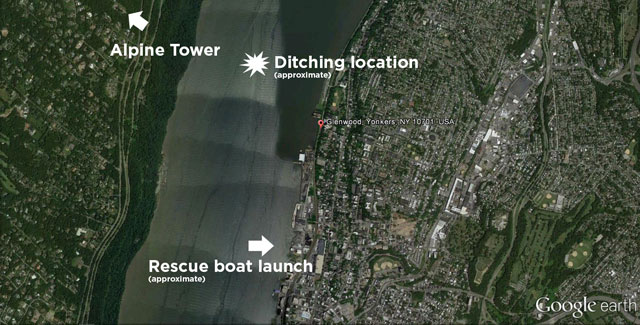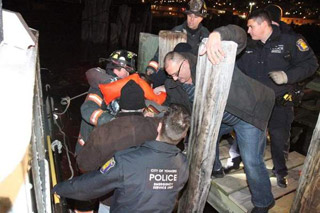 Rescuers launched a boat about a mile south of where the stricken Cherokee Six was forced to make an emergency landing in the river."
Rescuers launched a boat about a mile south of where the stricken Cherokee Six was forced to make an emergency landing in the river."
An evening tour above the Hudson River might have turned tragic, but pilot Deniece De Priester kept her cool when the engine quit—and landed like Sully.
A cellphone call at 5:25 p.m. Eastern on Jan. 27—four years, 12 days after US Airways Capt. Chesley “Sully” Sullenberger and First Officer Jeff Skiles ditched an Airbus A320 a few miles south—summoned Yonkers, N.Y., police, who manned a boat and hustled upstream as the airplane sank.
De Priester, 39, was making her second flight of the day along the popular VFR route, uncontrolled airspace just below New York Class B airspace with a 1,300-foot ceiling. Pilots announce passing various visual checkpoints on a common frequency, but are not in contact with ATC, and De Priester said there was little time for Maydays as she focused her full attention on maintaining best glide speed and setting up for a life-or-death landing she would have just one chance to get right.
Another thing she has in common with Sullenberger: glider and seaplane time. “That experience was very useful,” she said.
De Priester said the key to success was maintaining the right attitude as the fixed-gear Cherokee Six settled over the water—nose high, so the tail would hit first and start to break the surface cohesion of the water, but not too high. The aircraft came to rest right-side up, and floated for “about five minutes,” she said—long enough for her and passenger Christopher Smidt to call family, and 911. (De Priester had put out a quick distress call over the common traffic frequency on the way down, asking fellow pilots to relay the Mayday, but heard no response and had no time to think about switching to 121.5 until the landing was complete.)
 Having life jackets on board may well have saved the lives of pilot and passenger, surrounded by police and firefighters in this Yonkers Police Dept. photo.
Having life jackets on board may well have saved the lives of pilot and passenger, surrounded by police and firefighters in this Yonkers Police Dept. photo.
Yonkers police, including off-duty personnel, rushed to the nearest boat after Smidt connected with a 911 operator. A transcript of the call was released by police.
“We’re at the Alpine Tower. We’re in the middle of the Hudson,” Smidt told the operator, naming a checkpoint on the VFR route just across the river from Yonkers, N.Y. “We are in the plane. The plane is taking on water.”
Smidt and De Priester headed to the rear door, as the Cherokee Six was sinking nose-down, quickly. They were able to don life jackets, a safety tool that was likely another key to their survival in roughly 35-degree water, cold enough that muscles begin to fail in minutes. The boat arrived within 23 minutes of the call, authorities said, though De Priester said it felt like a longer swim than that.
“My fingers are still numb,” she said in the telephone interview two days later.
Skiles, now serving as vice president of chapters and youth education for the Experimental Aircraft Association, said the outcome speaks to De Priester's skill, and also serves as an important reminder for all pilots that there will be little time to act when the engine fails—particularly at that altitude.
“You’ve got a minute or two, at most, to plan, make a decision and execute a safe landing,” Skiles said. “That’s not a lot of time.”
Skiles said research on human factors has borne out that it takes 20 to 30 seconds or more for a pilot to recognize an emergency, assess the options, make a plan, and begin to execute it. In the case of Flight 1549, Skiles and Sullenberger had the benefit of intensive training on crew resource management that goes beyond the typical curriculum taught to general aviation or corporate pilots. That, along with the fact they saw the geese before impact, helped them respond more quickly than they otherwise might have. Similar training may have helped De Priester: She has previously served as a first officer in regional jets for Mesa Airlines, and also as a flight attendant, so is well-trained in emergency egress.
“That certainly showed with the results,” Skiles said. “Clearly, she was very calm and handled the situation properly.”
De Priester said she is declining a barrage of interview requests from the general news media for now, opting to give the NTSB and FAA time to investigate. For that reason, she opted not to attend a Jan. 29 ceremony organized by the mayor of Yonkers to honor officers who rushed to the rescue and plucked pilot and passenger from the water before the cold claimed their lives. Both pilot and passenger were treated for hypothermia at a local hospital and released.
She said she looks forward to a more detailed retelling of the story in the future, and working with AOPA to help highlight the lessons learned.
“I hope we all can learn from this,” De Priester said.
Skiles said one lesson that is often lost on pilots is the lack of options for an emergency landing in a crowded metropolitan area.
“We don’t really think about that: If you lost an engine right now, where would you land?” Skiles said. “Frankly both Sully and I, and this individual, were fortunate to have a river there.”



